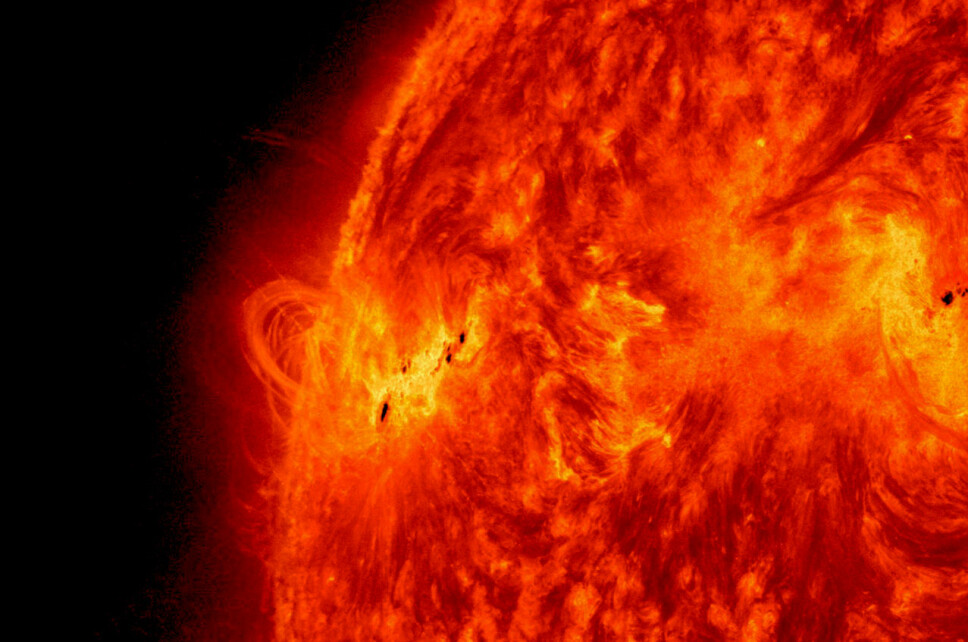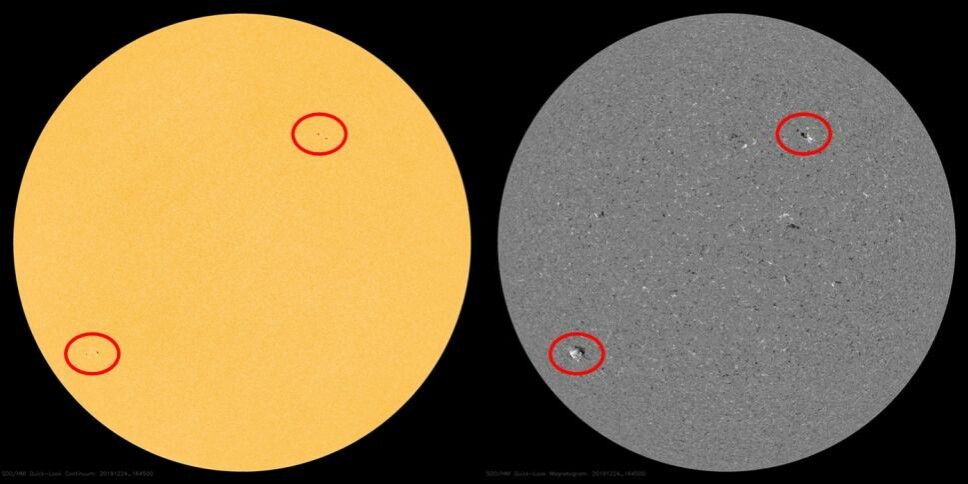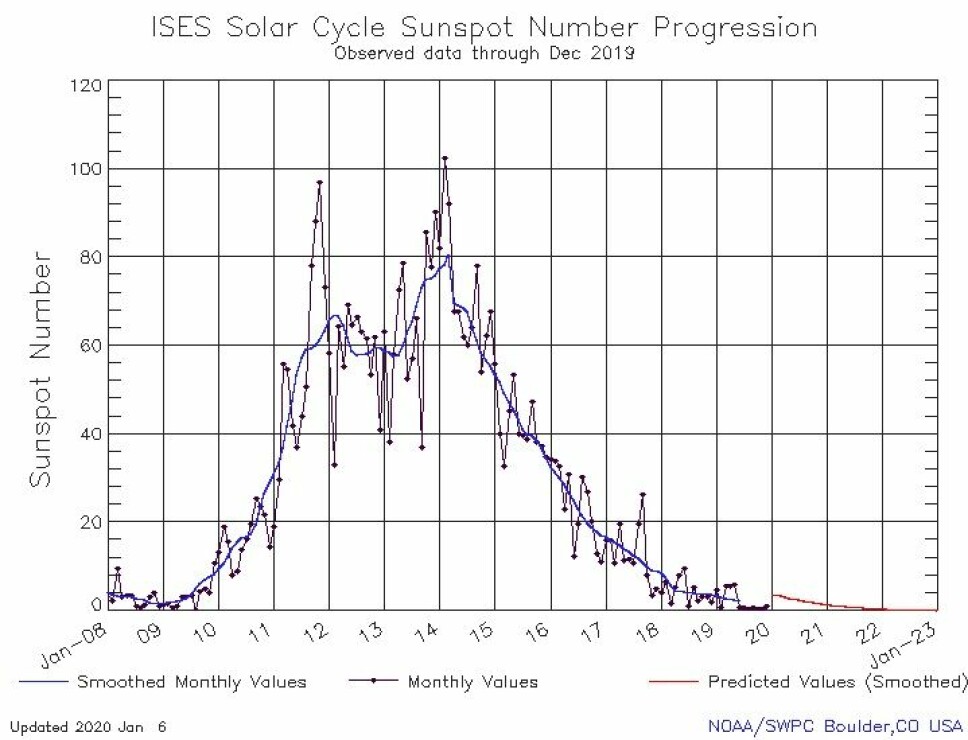
A new solar cycle may be underway
A new solar cycle has probably begun. It may peak in just a few years.
The sun seems immutable. That the sun rises in the morning and will shine in the same way it did yesterday is something we all can take for granted.
But the sun is constantly changing. To wit: right now, we’re probably at the beginning of a new solar cycle, which is a roughly eleven-year period when solar activity has bottomed out, and is on its way up again.
“The sunspots we are now seeing correspond to a new solar cycle,” Mats Carlsson says to sciencenorway.no. He is a solar physicist and professor at the Rosseland Centre for Solar Physics at the University of Oslo.
And although the effect is hardly noticeable, the total amount of energy from the sun changes during this period. From the minimum to the maximum, there is a small but measurable increase in energy of around 0.1 per cent.
There will also be a higher risk of solar storms when the cycle reaches its peak. Solar storms are huge discharges of charged particles that are ejected from the sun. If these radiation fronts hit the earth, they could wreak havoc on satellites, the power grid and other high-tech equipment.
Solar Cycle 25
Sunspots are a major indicator of where we are in the solar cycle. Sunspots are dark spots on the sun's surface, which are the result of intense magnetic activity in the sun's interior. There can be many of these spots when the sun is at its most active.
Many sunspots mean the sun is at its most active, while few or no spots mean it is at the nadir of its activity. This "relaxed" solar period is now behind us, because the sun had a long period at the end of 2019 without a single spot.
“In November and December there were 40 days without spots, which is very long. That's the longest in more than 20 years,” Carlsson said to sciencenorway.no.
Several factors thus suggest that the next cycle is about to begin. It is being called solar cycle 25, and if it has indeed begun, the previous cycle lasted from 2009 to 2020.
The solar cycle is caused by the sun's intense magnetic field twisting and rotating. Over the course of eleven years, the sun’s north and south poles swap places.
This whole process is driven by the fact that much of the sun is not a static ball of matter, but more like a sphere of liquid matter. This causes the sun to spin faster at the equator than at the poles. At the equator, the sun spends about 24 days to go around once, while it takes about 40 days for a single rotation closer to the poles.
This causes the sun's magnetic field to twist and rotate, like strands of spaghetti that are twisted around and into each other. When this twist is relaxed again, the sun calms down.

Flipping poles
New spots that have recently appeared belong to the new solar cycle. The sunspots can persist from a few days to several months, and new ones are constantly emerging.
“The spots appear in pairs, and the leading spot says something about which cycle it belongs to,” Carlsson said.
The spots can behave in many different ways, but they generally appear in pairs of different magnetic polarity. This means that they have a magnetic signature, which corresponds to a regular two-pole magnet. One spot is "north" and the other is "south".
But different cycles have opposite polarity on the spots. If the leading spot was "north" in the previous cycle, the new leading spots would be "south". This also changes if you look at the northern or southern hemisphere of the sun.
Thus, astronomers have observed several sunspots that probably belong to the next solar cycle, but we can’t say for certain that it has begun yet. We won’t know until several months of observations allow astronomers to see how the sunspots develop.
The American space weather forecast, from the Space Weather Prediction Center, says that solar cycle 25 may have begun in April 2020, according to Space.com.
Where spots appear also tells astronomers something about where in a cycle the sun is. At the start of a cycle, they appear higher on both hemispheres, and then move toward the equator toward the end of the cycle. Thus, spots from both the previous and the current cycle can be found on the sun simultaneously.
Although the new cycle is called number 25, there have been countless solar cycles until now. The sun is about five billion years old, and there is every reason to believe the sun has gone through these kinds of cycles for most of its existence.
But solar cycles were not numbered until, in the 19th century, mathematician Johan Rudolf Wolf began counting them, even though several well-known astronomers had noted and counted sunspots before that time.
Galileo Galilei observed and drew diagrams of the spots he observed on the sun in the 1610s.
But what do we know about the new sunspot cycle that appears to be on our doorstep? What's going to happen?

A calm sun
The previous cycle was among the quietest in the last hundred years. When cycle 24 was at its peak in 2014, there had been 116 sunspot. The sunspot number tells us about how many sunspots and groups of sunspots have been seen on the sun, and is calculated using a special formula.
In comparison, there were 285 sun spots when cycle 19 was at its peak in the 1950s, according to a review of solar cycles by the Sunspot Index and Long-term Solar Observations website. Theoretically, this increases the likelihood of eruptions and solar storms.
Several researchers are trying to develop ways to issue alerts and predictions about solar cycles. One of the latest predictions for cycle 25 says it will be quite similar to the previous one, but a little less active.
This particular assessment was done by the Space Weather Prediction Center, which predicts a new peak in July 2025, give or take eight months. At that time, the peak is expected to be reached with sunspot number 115.
But the warnings have not been entirely reliable, Carlsson says.
For example, something completely unexpected happened during the previous solar cycle.
“It had a double peak — a maximum in 2011 and then a new maximum in 2014,” he said to sciencenorway.no.
And predictions have varied widely. Several predictions said the cycle would be quieter than it actually was, reaching its peak in 2013, according to a compilation published in Space Weather in 2015. Other, previous predictions said the previous cycle would be very powerful, and the strongest in 400 years, according to NASA.

“You try to identify different phenomena on the sun that are related to the cycle. But there is no clear cause and effect that can be proved,” says Carlsson. “Modelling relationships on the sun is very complicated.”
This makes it difficult to say what the future will be like, but Carlsson also says there has been a general downward trend.
Low activity for decades
There was a long period of solar activity in the mid-17th century called the Maunder Minimum. At that time, the sun’s activity was low for decades, which means that the regular cycle was somehow disrupted.
This minimum has been linked to colder winters on parts of the Earth, but there is uncertainty about how big the effect really was.
Carlsson says that several researchers have wondered if the sun has been heading for a new, long minimum, especially because the break between cycles 23 and 24 was so long.
It lasted between 2008 and 2010.
“It was unusually long, but then the cycle started nonetheless,” he said
Carlsson says it seems like solar cycle 24 and the possible start-up of number 25 are more normal when it comes to the longer timetable.
At the same time, cycle 24 was abnormally weak, with few spots compared to the cycles that came before.
So we’ll just have to wait a few years to see what solar cycle 25 will bring.
Translated by: Nancy Bazilchuk
———































